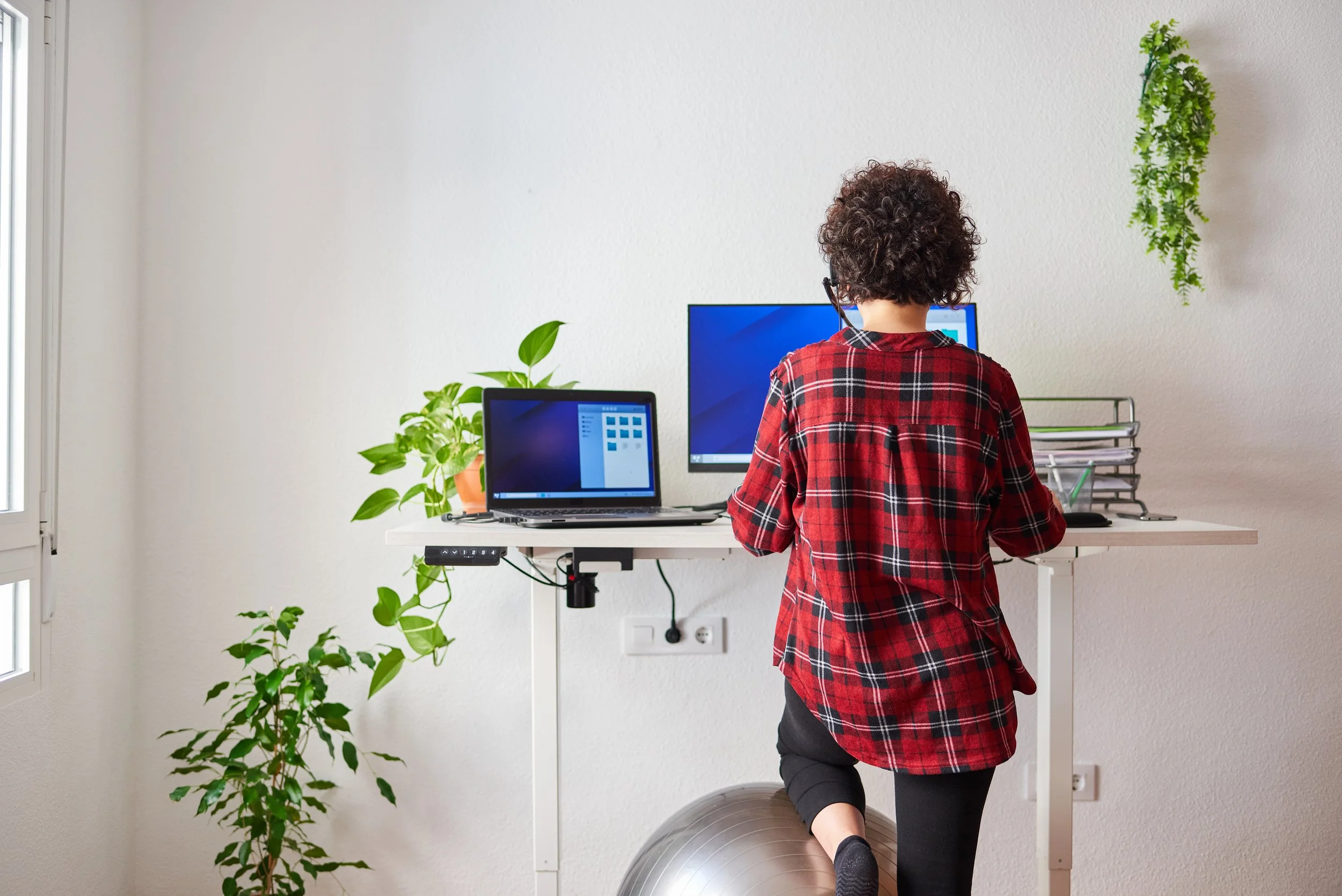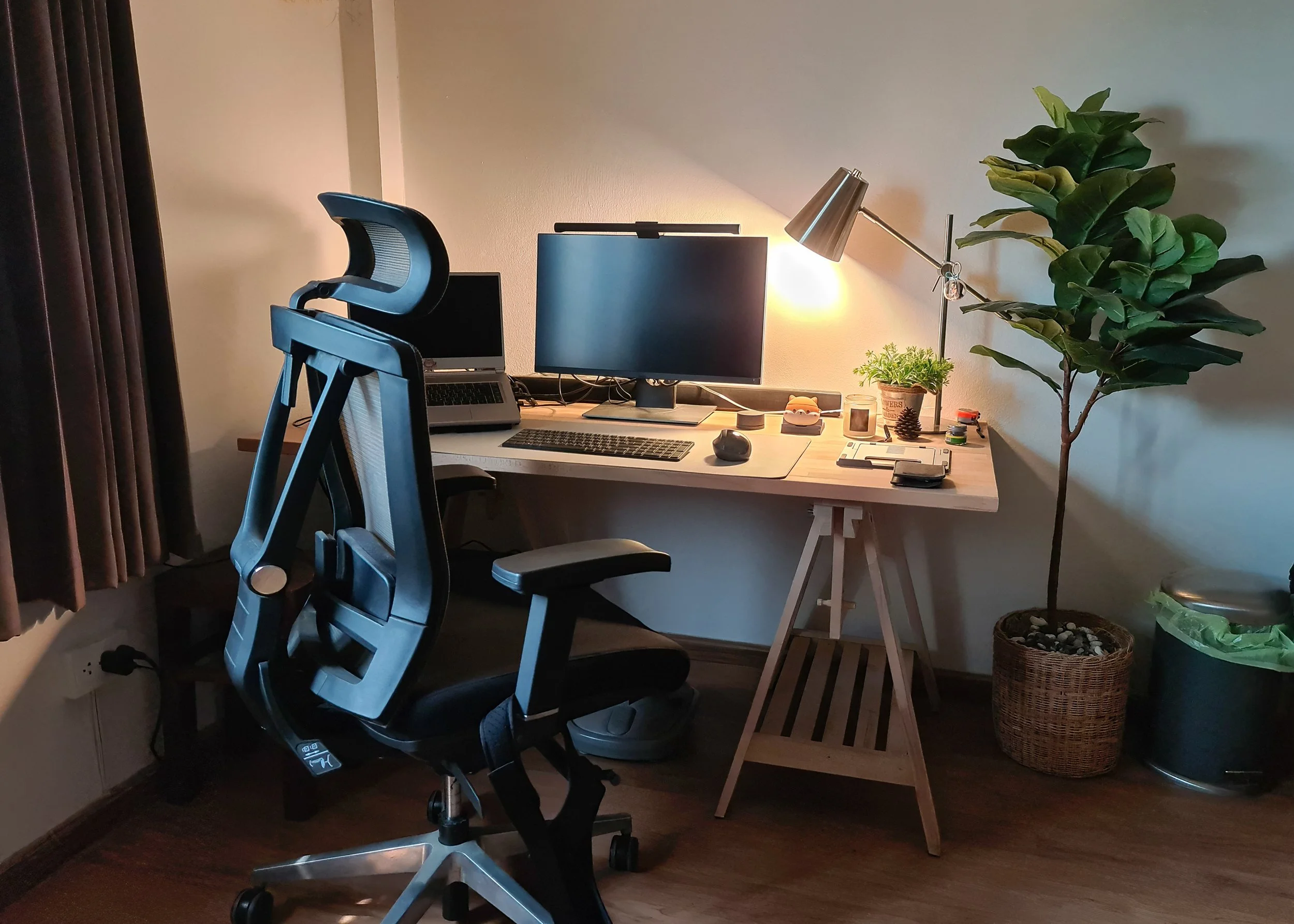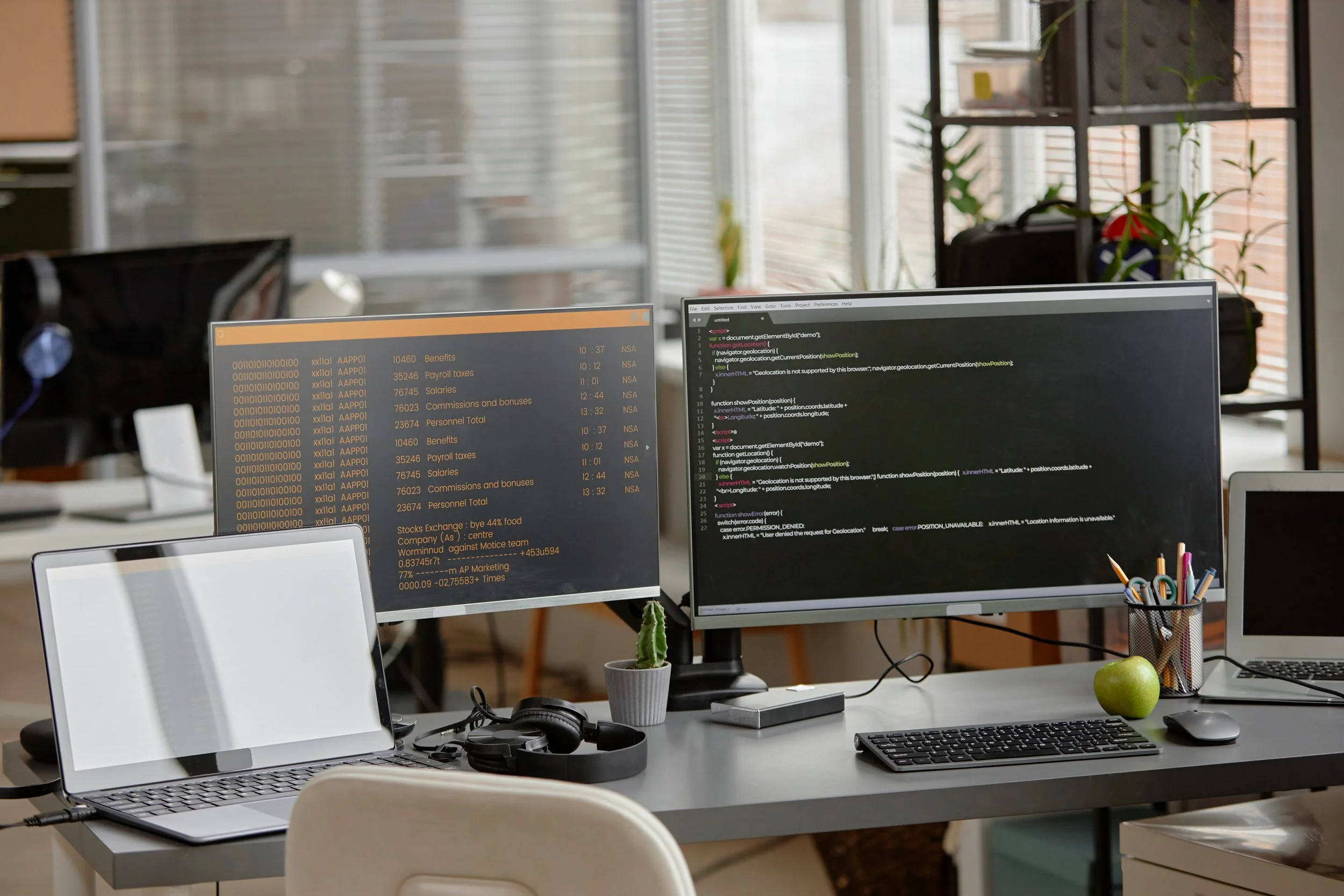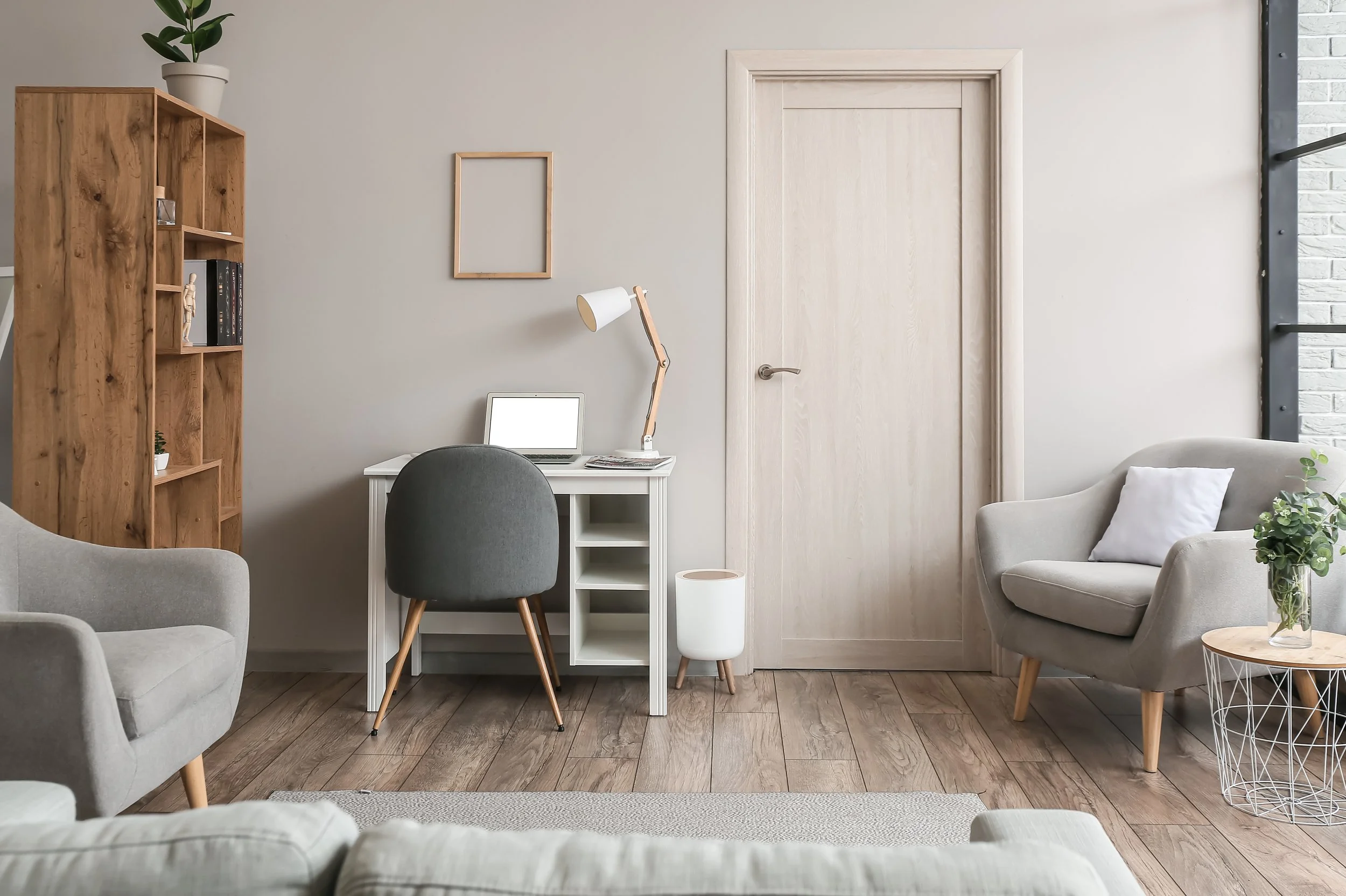Setting Up a Productive Workspace
The start of a new year often inspires us to set goals, establish habits, and refresh routines. For many, the packed and busy holiday season can leave us feeling scattered and craving focus and consistency. The new year can be thought of as a blank slate: a time to implement fresh practices that aid us in reaching our goals, both long- and short-term. What better way to boost your productivity than curating a clean and organized workspace within your apartment where the to-do list gets done? Whether you work a remote or hybrid schedule or simply need a designated place to check emails and pay bills, a productivity space can help you get the job done.
Creating an optimal home office can be boiled down to 5 key components: a sturdy desk, a comfortable chair, up-to-date tech, intuitive organization, and a mindfully selected environment.
Setting Up a Spacious Surface
A spacious and sturdy office desk, often the centerpiece of a productive workspace, is the place where productivity flourishes. Depending on the type of work you will be accomplishing and how much time you will spend there, the size and features that make up your work desk will vary. For example if all of your work is condensed into one laptop, a small and simple standing desk may be more than sufficient to support a busy digital workload. Alternatively, if you need space to store paperwork, art or crafting supplies, or multiple devices and screens, a sophisticated organization system can support a smooth workflow. In such cases, a fully equipped workstation consisting of a computer desk attached to a shelving unit provides plenty of space for work and properly stores needed items within arm’s reach. Depending on your personal priorities, space saving furniture may be more important than large work surfaces. Corner desks easily tuck into the edge of the room providing a cozy work nook with a healthy distance of separation from the rest of the room making it a perfect solution for apartment living.
Sit Comfortably
Arguably just as, if not more, important than a good work desk is a comfortable and ergonomic office chair. Beyond general discomfort, a poorly constructed office chair can lead to lasting health issues such as back pain. It is important to find a chair that both feels comfortable and is intentionally designed with the health of the user in mind. Certain chiropractor recommended features can actually contribute to maintaining proper back support and posture. Adjustable armrests give the shoulders the opportunity to relax without slouching. Swivels are important features that allow the user to face any direction while preventing the neck from twisting or straining. An adjustable seat height makes it possible to sit comfortably, feet flat and arms at rest. The width and depth of the seat should be accommodating to your body with a forward and backward adjustable tilt. Lumbar support is designed to curve with the natural shape of the spine so that the back can be properly supported, while a wide adjustable backrest makes it possible for the chair to custom form to each user. Finally, the chair should be constructed with sufficient padding and a breathable fabric for comfort and air flow. (Cite) With thousands of chairs available claiming to be the best ergonomic office chair for posture, it can be hard to determine which one is actually the best for you. Luckily, researchers at Wired and New York Magazine have done the work for you! No matter your budget or aesthetic preference, there is a chair out there for you, from the time-tested Herman Miller Aeron to the trendy and stream-lined Branch Ergonomic Pro or the budget friendly Union & Scale Hyken. When designing a home workspace, it’s important to prioritize health by finding an ergonomic chair that supports your posture and keeps you comfortable.
Tech Upgrades
In addition to having sturdy home office furniture, your workspace may benefit from a fresh tech upgrade. Technology for work from home jobs has made leaps and bounds in recent years. Depending on the tasks you need to perform, you may want to consider acquiring new and upgraded devices to make your job smoother. For work that requires working remotely in a variety of locations, a high quality laptop can make work-on-the-go not just possible, but convenient and efficient. For the time you spend working at home, it can also be helpful to hook up your laptop to a larger computer monitor or two to increase your workload capability. The larger screens mean more windows can remain open at the same time and complex tasks become a little bit easier. Make sure to grab either a docking station or adapter to hook up your laptop to all of your devices with one cord. A keyboard and mouse set tend to be easier to use than a laptop keyboard and trackpad, while choosing a wireless set can keep your desk free of the tangle of unnecessary cords. In addition to the basic essentials, create a list of any other tech that can improve your work experience and efficiency at home. For example, it's important to invest in a good webcam and headset for clear sound and picture during meetings and calls. Alternatively, external speakers can give your setup greater volume range.
Get Organized
Beyond the equipment we use, how we organize our entire set up impacts our productivity. Make sure that your apartment office space is free of excess items and clutter. Equip yourself with proper containers for all loose office supplies, drawers for pens and notepads, and shelving or stands for devices such as a phone or tablet. This may take some trial and error, but it is important that organization be optimized for your personal workflow. For example, if you need books, notepads, and printer paper they should all be readily accessible but not in the way, so as interrupting your work. If your desk does not come with the necessary shelving and drawer systems already installed, you can create additional storage space by adding a small filing cabinet or floating wall shelves. If you have multiple reference books that you need to access regularly, try this viral dish rack bookshelf hack to display volumes in a clean aesthetic way! The best part is - it can be installed with command strips making it apartment and lease friendly! Perhaps one of the hardest organizational challenges of an office set up is keeping cables from getting tangled and messy. When it comes to cable management, power strips and surge protectors are your new best friend. Install enough surge protectors to plug in all of your cables in a localized spot. You can even attach these to the bottom of the desk to ensure that all of the cables remain out of the regular line of sight. Cable boxes and trays can contain and hide additional loose wiring. Cable trays are particularly useful as they allow you to run the wire while and to the exact spot where you need it to go. For detailed tips and instructions, follow along with a tutorial such as this one to learn how to manage your cables on a budget like a pro. When configuring your setup, be cautious to not overload power strips and outlets as this can pose a fire hazard. Find tips for fire safety in our recent blog article.
Choose an Optimal Environment
The final component of a successful home office setup is choosing the best environment for your work space. When choosing the best spot, good lighting and airflow should be at the top of your criteria list. A corner of a room near a bright window is a great place for your desk. Having plenty of natural light keeps you focused and alert as you lock in for the day. If the best spot for your office is lacking in natural light, you can compensate for that with led strip lighting, desk lamps and floor lamps. Being in an open environment or near a window is important for cross breeze to flow through helps to keep your mind clear and keep the space comfortable while you work. Additionally, creating a separation between your work space and your rest or recreation space also helps to improve both your productivity and your ability to mentally “clock out” when the work is done. While of course it can be ideal to have a separate room just for an office, that may not always be realistic. Luckily there are many ways to designate that separation. For example, utilizing a room divider or partition can give the feeling of two separate rooms, even if there is no wall and door dividing them. The same idea can be accomplished using a tall bookshelf, which creates the concept of separation without blocking off the work space. Orienting your work station away from the spaces in the room can also mentally send you the message that “work goes over here.” Lastly, shutting down all work devices entirely once the day is done is a great way to draw a hard boundary between work time and personal time.
The first step in accomplishing your goals for 2025 may be creating a productive space where your work can get done and focus can be fostered. Implementing these key elements conducive to curating a healthy work environment can support you on your journey to accomplishing these big goals and fostering new dreams for the years to come!






